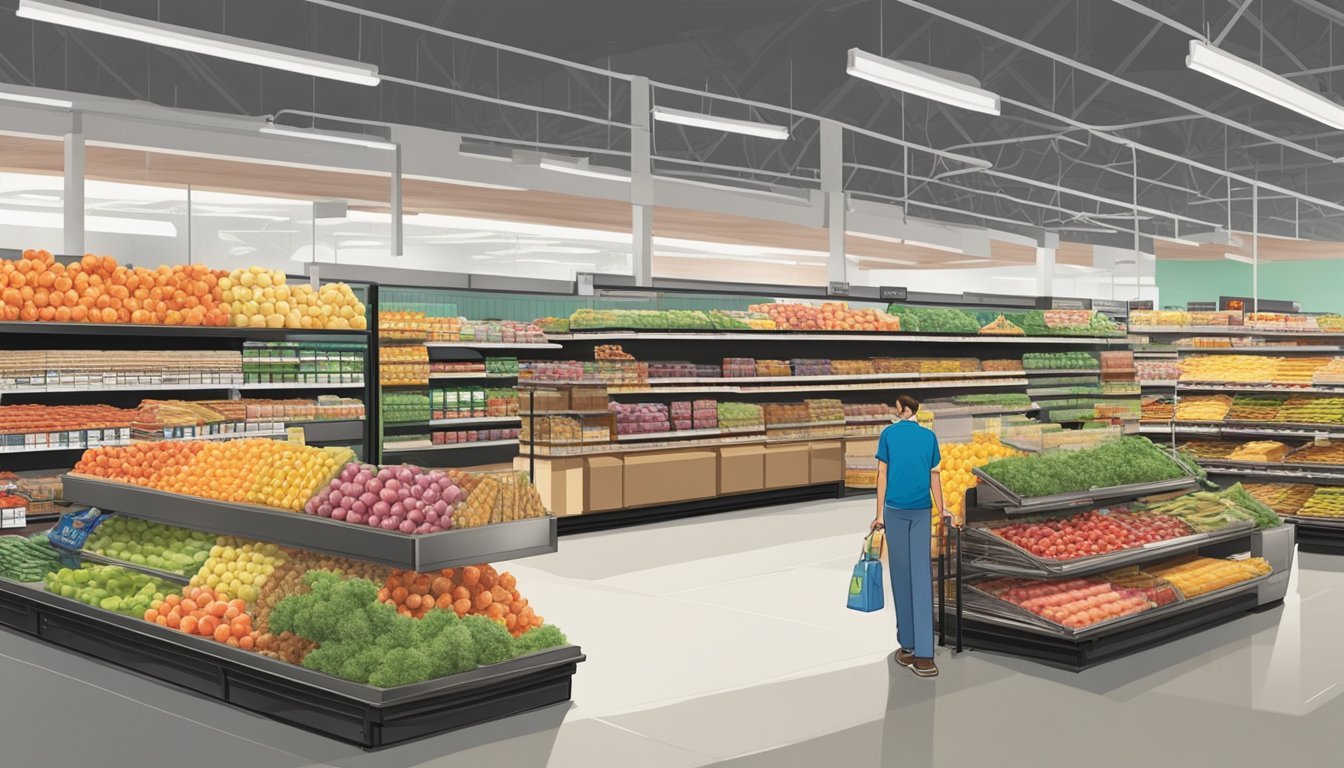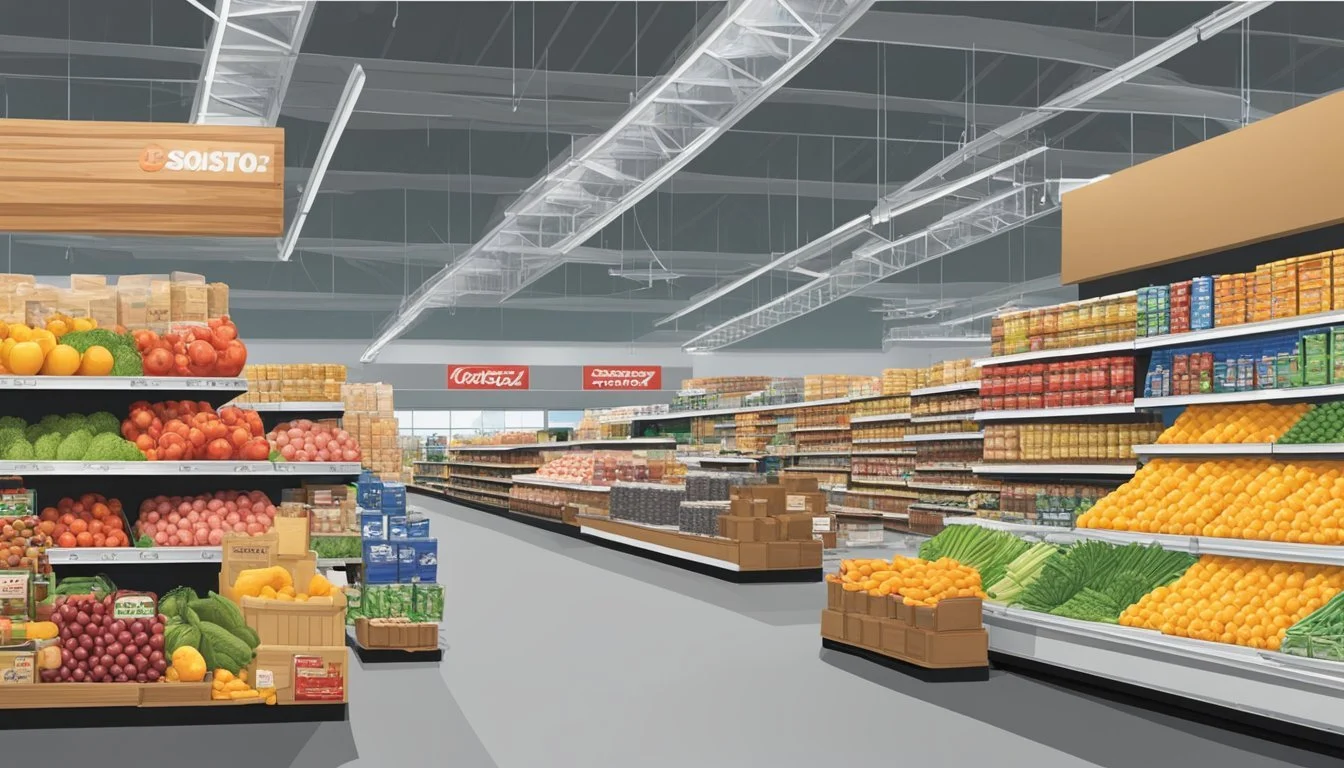Costco vs Piggly Wiggly
Comparing Grocery Store Value and Selection
Part of Our Grocery Store Guide with Details on Costco and Piggly Wiggly
Navigating the aisles of America's diverse range of grocery stores, shoppers often weigh their options between retailers like Costco and Piggly Wiggly. Each store offers a distinct shopping experience, and the preferences of consumers may vary based on several factors including product selection, pricing, store environment, and customer service. Costco is known for its membership-based warehouse format, supplying a wide variety of items in bulk at competitive prices. Piggly Wiggly, on the other hand, adopts a traditional supermarket model, with a focus on convenience and community presence.
Cost-based analysis of shopping at the two chains reveals a stark difference in their retail strategies. Costco's bulk goods often attract consumers looking for savings in larger quantities, which is ideal for families or those willing to stock up. In contrast, Piggly Wiggly offers a more conventional approach to grocery shopping, with smaller package sizes and a familiar store layout. This has implications not only for the pricing but also for the shopping experience. The cost efficiency and product range at Costco are often juxtaposed against the community-centric and easily navigable layout of Piggly Wiggly stores.
In assessing which grocery store is better, it is essential to consider the diverse needs of the consumer base. While some may prioritize the overall savings and the vast product range Costco provides, others might value the proximity, immediate service, and classic supermarket experience that Piggly Wiggly offers. Therefore, determining the superior grocery store between Costco and Piggly Wiggly is not a matter of objective superiority but one of aligning a store's offerings with the priorities of the shopper.
Company overview
In the realm of grocery chains, two names stand out for their distinctive histories and business models: Costco and Piggly Wiggly. Both have carved unique paths in the supermarket industry, evolving from their early beginnings to become entities known for their specific brands of service and customer experience.
History of Costco
Costco Wholesale Corporation, launched under the Costco name in 1983 in Seattle, emerged from the merger of Price Club, founded in San Diego in 1976, with Costco in 1993. They pioneered the membership warehouse club model, where members could purchase a wide range of products in bulk at competitive prices. Through consistent growth, Costco has become the fifth largest retailer in the world and the largest membership warehouse club chain in the United States.
History of Piggly Wiggly
Piggly Wiggly, LLC, heralded as the first self-service grocery store, was founded in Memphis, Tennessee, by Clarence Saunders in 1916. It revolutionized the way grocery business was conducted, granting customers the freedom to browse aisles and select goods without a clerk's assistance. While not expressly mentioned in the search results, the company's parent structure has been involved in various acquisitions, including a reported sale of approximately 400 stores to C&S Wholesale Grocers, indicating an adaptive and strategic approach to expanding its retail presence. Piggly Wiggly has maintained a strong Southern identity but also reached other regions, resonating with consumers through its community focus and convenience.
Store Formats and Layouts
In evaluating Costco and Piggly Wiggly, different store formats cater to varied consumer needs. Costco operates with a warehouse model promoting bulk purchases, while Piggly Wiggly offers a more traditional grocery store experience with a focus on community convenience.
Costco Warehouse Model
Costco is characterized by its large warehouse format, presenting a broad array of merchandise in bulk. Shoppers navigate through what is often described as a "racetrack" layout—a design that guides them along a set path, ensuring exposure to a wide range of products. The openness of the warehouse allows for easy cleaning and maintenance, contributing to its overall cleanliness and shopping experience. One can find products ranging from electronics to groceries, emphasizing the store as a one-stop shop for all household needs.
Piggly Wiggly Community Stores
In contrast, Piggly Wiggly introduced the concept of self-service grocery shopping, which has become the standard. Stores are generally smaller and tailored for a straightforward shopping experience. Consumers are presented with well-organized aisles labeled with clear signage, aiding in a more traditional and localized shopping journey. Piggly Wiggly's commitment to the community is seen in their store's assimilation with local tastes and preferences. They maintain cleanliness with consistent upkeep and a more segmented store layout, making it easier to manage day-to-day cleanliness tasks efficiently.
Pricing Strategies
Piggly Wiggly and Costco utilize distinct pricing strategies that influence their customers' shopping experience. Piggly Wiggly offers low prices to attract a value-driven demographic, particularly in the Southern United States where it boasts over 600 locations. By setting lower price points, they appeal to budget-conscious shoppers looking to save money on their grocery bills.
Costco, in contrast, operates on a membership model which provides customers with access to wholesale prices. Despite medium-high price levels on individual items, the bulk purchasing option yields a lower price per unit, making it a cost-effective solution for those who can buy in larger quantities. This approach is particularly beneficial for large families or businesses in need of stocking up on supplies.
When examining a price comparison, shoppers may find that Costco's bulk pricing on items like almond milk or eggs offers more savings over time, versus Piggly Wiggly's already low per-item prices. However, customers must also consider the annual membership fee Costco charges which adds to the overall cost.
Here is a summarized comparison:
Costco: Offers bulk items at a lower unit cost, with medium-high sticker prices. Membership fees apply.
Piggly Wiggly: Provides consistently low prices across a range of products without any membership fees.
Each store's strategy has its benefits, and the better option largely depends on the customer's shopping habits and immediate needs.
Product Range and Quality
When comparing Costco and Piggly Wiggly, discerning shoppers look closely at the variety and caliber of products offered. Each store has distinct offerings, and their proprietary brands often reflect differing quality levels and price points.
Fresh Produce Selection
Costco is renowned for its wide array of fresh produce, offered in bulk quantities, suitable for families and those hosting large gatherings. They consistently prioritize freshness and quality, frequently stocking seasonal items to ensure variety. Piggly Wiggly provides a fresh market experience with a focus on regional produce, and while their selection may be less extensive, it caters well to their customer base's preferences.
Meat and Dairy
Both stores showcase a selection of meat and dairy products. Costco excels with their Kirkland Signature meats, offering quality cuts in larger volumes, often appealing to shoppers seeking value without compromising quality. Piggly Wiggly has a reputation for sourcing from local suppliers, giving customers access to fresh, regionally-sourced meat and dairy items.
Bakery and Dry Goods
Costco boasts a robust bakery section, featuring breads, pies, and cakes that emphasize both freshness and size. Their dry goods, ranging from cereals to nuts, are presented in quantity-efficient packaging. Piggly Wiggly competes with a selection of bakery items that may include local favorites and prides itself on offering a variety of dry goods that meet the needs of their local customer base.
Store Brand Offerings
The store brand is a significant differentiator. Costco's Kirkland Signature line encompasses a wide spectrum from peanut butter to laundry detergent, beloved for its affordability and quality. In contrast, Piggly Wiggly offers store-branded items that are competitively priced, providing cost savings to their shoppers, with some items such as sliced cheeses and sour cream being well-received by consumers for their quality and value.
Membership and Benefits
When evaluating grocery stores like Costco and Piggly Wiggly, membership options and the benefits they provide are crucial for customers to consider. Each store offers unique programs that reward shoppers and enhance the overall shopping experience.
Costco Membership
Costco operates on a membership-based model, offering two main membership tiers: Executive and Gold Star. The Gold Star membership is priced at $60 annually, providing members with access to any Costco location worldwide as well as online shopping privileges. The Executive membership has a higher fee of $120 annually, but it includes all the benefits of the Gold Star level with the addition of an annual 2% Reward on qualified Costco purchases, which is capped at a maximum reward of $1,000.
Gold Star Membership
Annual Fee: $60
Access: All Costco locations and online shopping
Household Card: Included
Executive Membership
Annual Fee: $120
Reward: 2% on qualified purchases, max reward of $1,000
Additional Benefits: Vary by location and may include savings on travel and services
Shoppers often find the Executive membership more valuable if they frequently shop at Costco or make significant purchases due to the potential rewards that can offset the cost of the higher membership fee.
Piggly Wiggly Rewards
Unlike Costco, Piggly Wiggly does not require a membership fee to shop at its stores. Instead, it offers a loyalty program called Piggly Wiggly Rewards. Customers can sign up for a rewards card which allows them to take advantage of special deals, discounts, and promotions. The rewards system is straightforward:
Piggly Wiggly Rewards Card
Cost: Free
Benefits: Access to special deals and discounts
Benefits are applied directly at the register when the card is scanned, making the process simple for shoppers. Piggly Wiggly's rewards program can be particularly appealing to customers who prefer not to pay an upfront fee for the potential savings while shopping.
Customer Experience
In assessing the customer experience at grocery chains like Costco and Piggly Wiggly, shoppers often emphasize the shopping environment and overall satisfaction derived from their visits.
Shopping Environment
Costco provides a warehouse-style shopping experience with bulk items and a variety of merchandise beyond groceries. The stores are spacious but can be overwhelming due to their size and the volume of options available. They often include additional services such as pharmacies, optical centers, and food courts, contributing to a diverse shopping experience.
Piggly Wiggly takes a different approach with a more traditional supermarket feel. The stores generally offer a familiar grocery shopping environment that's relatively easy to navigate. Known for its regional presence, Piggly Wiggly’s store layout and design typically reflects the local community’s preferences, making it feel more personalized.
Customer Satisfaction
Costco's customer satisfaction is bolstered by its competitive pricing, especially for members who take advantage of the membership model for discounts on bulk items. Additionally, Costco's return policy is known for being customer-friendly, instilling a high level of trust and loyalty among its shoppers.
In contrast, Piggly Wiggly fosters customer satisfaction through its localized approach to service; it often resonates with shoppers preferring a traditional and community-focused shopping experience. The brand's customer service is frequently cited as friendly and accommodating, maintaining a strong base of satisfied customers.
Geographical Presence
Costco and Piggly Wiggly cater to different markets in terms of their geographical footprint. Costco operates globally with a significant presence in North America and various other countries. As of 2024, it boasts 566 locations globally, indicating its expansive reach and international market appeal.
Piggly Wiggly, on the other hand, has a more concentrated presence in the Southern United States. With an estimated 624 locations, its operations are heavily localized, serving as a community supermarket chain within this region.
The distribution of stores for both chains is as follows:
Costco
North America: Predominant
International: Substantial
Piggly Wiggly
Southern United States: Predominant
Other regions: Minimal to None
Shoppers in the Southern U.S. may find Piggly Wiggly stores to be highly accessible for their grocery needs, whereas Costco's reach allows both urban and suburban residents across North America and beyond to take advantage of its warehouse-style shopping experience. Neither chain's geographical footprint strictly implies quality or value; rather, it highlights the scope of their respective markets and potential accessibility to their customer base.
Services and Amenities
When looking at Costco and Piggly Wiggly, the services and amenities each store offers can notably enhance the shopping experience. Both chains have distinct features tailored to their customer base.
Pharmacy and Health Services
Costco provides a full-service pharmacy available to both members and non-members. They offer immunizations, wellness clinics, and medication management programs. The convenience of accessing these services while shopping for groceries can be a significant time-saver.
Immunizations: Flu shots, travel vaccines, and more
Health Screenings: Heart health, diabetes, and osteoporosis screenings
Medication Management: Sync your prescription refills
Piggly Wiggly focuses on essential pharmacy services, with select stores offering prescription refills and a smaller range of health-related services. They are committed to serving the local community with personalized attention.
Prescription Refills: Efficient service for medication needs
Health Advice: Pharmacists offer counsel on medication questions
Party and Bulk Purchases
Costco excels in party and bulk purchase options, catering to large events and businesses through its extensive inventory. Members can find a variety of party essentials in bulk, from food trays to decorations.
Food Trays: Prepared platters for any occasion
Bulk Items: Large quantities for parties and business needs
Piggly Wiggly stores accommodate party purchases, with a focus on delivering quality and value. Although they don't specialize in bulk, their commitment to the local community means they often know exactly what their customers need for gatherings.
Custom Orders: Tailored to customer specific party needs
Local Favorites: Offering regional specialties for events
Comparative Analysis
This section provides a focused examination of how Costco and Piggly Wiggly rank in consumer reports and how their pricing for various products stacks up against each other.
Consumer Reports and Studies
Consumer reports have consistently placed Costco at the higher end of supermarket rankings, noting its bulk buying options and member benefits as key advantages. Piggly Wiggly, on the other hand, has received mixed responses. In some studies, such as those listed by Kiplinger and MSN, Piggly Wiggly finds itself lower on the list, although it still boasts of a loyal customer base due to its presence in niche markets.
Price Comparisons Across Different Products
When comparing prices between Costco and Piggly Wiggly, one must consider the membership model of Costco, where savings are often realized over time and with bulk purchases. Here's a direct comparison for some key grocery items:
Product Costco Piggly Wiggly Eggs (1 dozen) $1.50 $2.00 Milk (1 gallon) $2.85 $3.49 Olive Oil (1L) $9.99 $12.99
*Prices are approximate and are subject to change.
It's evident that Costco offers competitive pricing, particularly for bulk items. Milk and eggs, staple products, are generally cheaper at Costco, an edge for the budget-conscious shopper. Piggly Wiggly's prices are higher, but they provide convenience and accessibility in certain regions where Costco might not be present.
Conclusion
When choosing between Costco and Piggly Wiggly, customers should consider several factors including pricing, product selection, and shopping experience.
Pricing:
Costco is known for its bulk purchasing options, which often translates into cost savings for customers who are looking to buy large quantities at once. It generally offers competitive deals on a wide range of products, from groceries to electronics.
Piggly Wiggly, on the other hand, is praised for its customer loyalty and localized approach, offering pricing that can be advantageous on a per-item basis through its cost-plus concept.
Product Selection:
Costco offers a wide variety of products, ranging from its own Kirkland Signature brand to a variety of national brands. Its selection is broad but is tailored to bulk purchasing.
Piggly Wiggly provides a more traditional grocery store experience, with a selection that varies by location, often focusing on regional preferences and including local brands.
Shopping Experience:
Costco requires a membership to shop, which can add to the shopping cost but also offers additional benefits and discounts. Its stores are large warehouse-style spaces.
Piggly Wiggly stores are typically easier to navigate and may provide a more personalized shopping experience. They often integrate within their communities, fostering strong customer loyalty.
In conclusion, both Costco and Piggly Wiggly have their own unique advantages. Shoppers should base their choice on their specific needs, shopping habits, and preferences. It's a personal decision that will vary from one customer to another.









